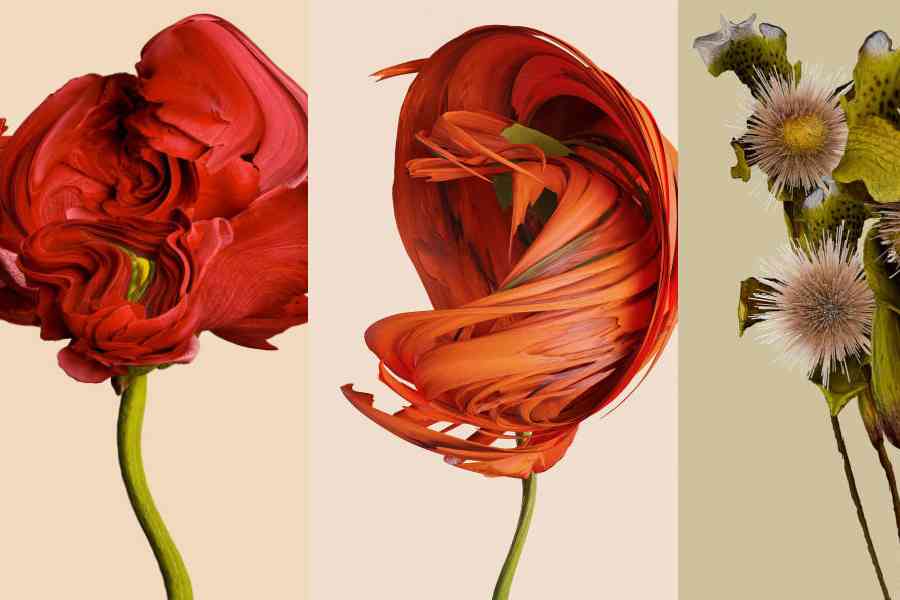Imagine setting out for a springtime stroll. Not here on Earth but on some distant planet — call it Novathis-458b — orbiting a distant star. Even light-years from home, you recognise some familiar pleasures. The sun (albeit a different sun) is shining. The roses are in bloom. A breeze is blowing.
But these are no ordinary roses and it is no everyday breeze. The wind clocks in at more than 15,000 miles per hour, and the flowers, Rosa aetherialis, have evolved to harness it. Their strong pink petals curl around a spiral interior that holds the plant’s reproductive organs. The spiral shape directs the supersonic wind through the centre of the flower to flush out its pollen and carry it across the planet.
If roses had evolved in a place like Novathis-458b — an imaginary place, but one that bears certain similarities to real exoplanets — this is what they might look like, Vincent Fournier, a French artist and photographer, posits in his otherworldly project, Flora Incognita, which was on display recently at the Association of International Photography Art Dealers show in New York in the US.
In images that are digital manipulations of real photographs, Fournier depicts how our flowers and plants might look had they evolved in the kinds of extreme conditions that exist in alien worlds.
The project, he explained, “reimagines our relationship with the living world by projecting an extraterrestrial version of our botanical heritage onto planets beyond our solar system”.
Scientists have not discovered definitive evidence of life beyond our own planet, but they have identified numerous exoplanets that might be capable of sustaining it. (Researchers recently announced that they had detected potential signs of life on a planet that orbits a star 120 light-years away.)
To make each image, Fournier began by taking photographs of real plants from multiple angles and then stitched those photos together into composite, three dimensional images.
He reviewed the scientific literature and consulted with scientists, including Jean-Sébastien Steyer at the French National Centre for Scientific Research in Grenoble, France, to learn more about the conditions that might exist on exoplanets and how plants might evolve to cope with them.
Then he worked with digital designers who used 3D animation software to manipulate each image, imagining potential adapt-ations to some of these alien conditions.
The results are simultaneously strange and familiar: an extra-fuzzy fern that is insulated from extreme temperatures and water loss. A subtly shimmering cactus that pulls heavy metals from the soil. A bristled orchid that captures minerals suspended in the air.
The images are not meant to be rigorous scientific predictions. “It is really an artistic work,” Fournier said. “But it’s a collaboration with scientists, and it’s fed by science.”
There are, however, many considerations that the images do not take into account. For instance, most potentially habitable exoplanets identified so far orbit stars that are much cooler and redder than our own Sun.
“Our sun kicks out a lot of energy, far more than most of the stars around which we’ve found Earthlike planets,” said Christopher Duffy, a theoretical biophysicist who recently moved into astrobiology at the Queen Mary University of London.
That could make photosynthesis difficult, he said, and favour the evolution of algae over land-based plants, which tend to require a lot of energy. Extraterrestrial plants might come in radically different colours.
“They’ll definitely be adapted to whatever light spectrum is there,” said Nancy Kiang, a biometeorologist at the Nasa Goddard Institute for Space Studies in the US. In some places, she said, they might even be black, “to make use of the visible light as much
as possible”.
On Earth, flowers have also evolved alongside pollinators, which would not be a given on distant worlds.
Still, these scientists, who spend their days making rigorous predictions about alien plant life, said that they were taken by the images and that there was a real role for imagination in this work.
“Human creativity has allowed us to reach for the stars and find those exciting new worlds on our cosmic horizon, and imagination helps us envision what they could look like,” said Lisa Kaltenegger, the director of the Carl Sagan Institute at Cornell University in the US and the author of Alien Earths.
Fournier hopes that the images spark a sense of wonder and an appreciation for how living organisms can adapt, even to environments that seem the most inhospitable.
“The cool thing about thinking about other planets is that it makes us question: what are our assumptions about life here, and what are things we shouldn’t take for granted?” Kiang said.
Art, too, can make us look at things differently, she said. And Fournier’s photos had made her want to do just that. “I think they’re beautiful,” Kiang said. “They make me want to go look at plants around my neighbourhood and figure out, why are they that way?”
NYTNS











